Okay, so you’ve already made two very big decisions when it comes to your next enduro bike. You want a two-stroke and you want something a little different than what your buddies are riding, like the Italian-made Beta—a great alternative to some of the more well-known brands out there. But you still have one very important decision left to make: 250 or 300? Here is where we come to the rescue. We tested them both.

Like KTM and Husqvarna, Beta offers two middleweight two-stroke enduro bikes—the 250 RR and 300 RR.
Good luck trying to tell them apart with your eyes. Visually they are identical. To tell them apart means you have to find the displacement designation printed nonchalantly on the left-side airbox access cover. Otherwise it’s mighty tough, seeing as how both bikes are, in fact, the same, except for the cylinder size.
Beta also sells a Race Edition of these models, which are geared more toward the racer and more aggressive rider. They also have a few high-grade components and, of course, a higher price tag.
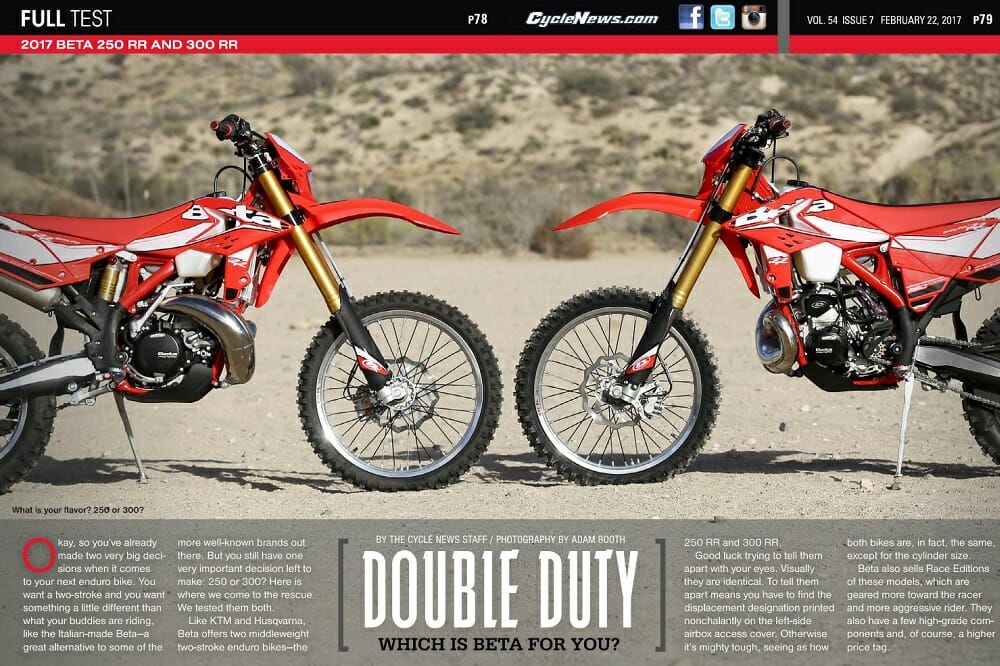
To read this in Cycle News Digital Edition Magazine, click HERE
PHOTOGRAPHY BY ADAM BOOTH
The 250 and 300 RR are off-road bikes, designed and set up for the average off-road rider and are not green sticker machines for those living in California, which means they don’t come with spark arrestors. However, we remedied that by quickly installing S/A FMF mufflers, making them legal to ride on public lands for our testing.
About the bikes
For 2017 Beta made only subtle changes to the 250/300 RR, which was an already great package. The Sachs fork is 5mm longer to provide a bit more wheel travel, and, inside, a higher grade fork oil reduces heat build-up and reduces friction. The Sachs shock has a new high/low speed adjustment system that Beta tells us is more sensitive when changing settings.
The triple clamps have been updated and are now lighter while providing more rigidity.
The proven two-stroke engine remains the same, featuring a six-speed transmission, electric start with a kickstart backup, an adjustable power-valve, a smooth-working hydraulic clutch and a dual-map ignition switch. The only difference between the 250RR and the 300RR comes in the size of piston and cylinder bore, 293.1cc versus 249cc. Stroke is the same at 72mm.
The sliver Excel rims with black spokes not only look cool, but are now lighter.
A new computer shows speed, average and maximum speeds and the ability to adjust mileage in smaller increments. It also has warning lights in regards to the level of the premix oil.
The RR’s also have an Allen wrench and 8mm socket hidden under the seat that helps the rider gain access to a tool stash area behind the left side panel and airbox. That area can hold tools or a 21-inch regular tube. Pretty cool.
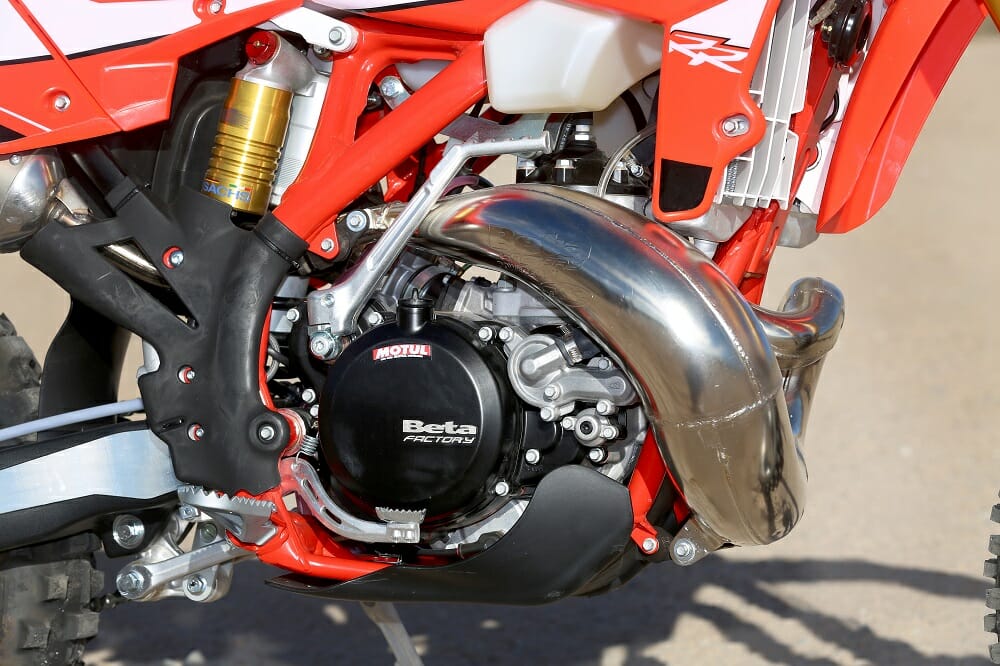
Back for 2017 on the RR two-stroke models is Beta’s Electronic Oil Injection system. The two-stroke oil is stored in a tank under the seat (which is easy to remove with just a push of a button) and holds 12 ounces of oil. The oil-injection is managed by an ECU, which feeds a precise amount of oil into the system based on rpm and engine load, measured through the throttle position system (TPS). The ratio varies from 32:1 to 100:1, depending on the demands of the rider and the terrain. The oil-injection system puts out a lot less tail pipe smoke and uses only as much premix oil as needed. To help keep the system rider friendly, two warning lights for oil level are built into the digital odometer.
Last year we were a bit wary of the oil-injection, but after spending a lot of time with it, we absolutely love it! Under normal off-road riding we got at least three tanks of gas for every full tank of premix oil. Under fast and aggressive you’ll get a little less, but we rode the 250 RR and 300 RR in a lot of single track and technical riding where engine rpm and loads weren’t too gnarly. Having the oil-injection system also makes it easy to borrow gas, or just obtain gas, on a long ride. The RR tank is 2.5 gallons, and again, the terrain and ride style is a big factor in mileage. We felt fairly safe on 50 miles rides with 2.5 gallons.
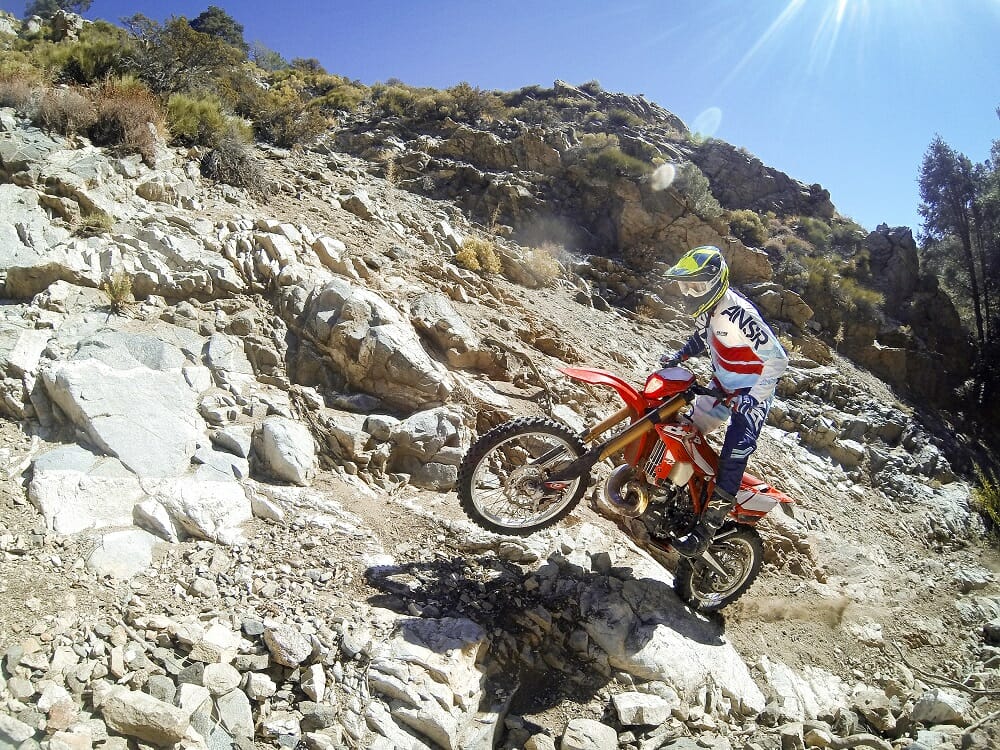
Modern gas, even if you buy 91 octane doesn’t sit well in carburetors for longer than a week or two before it begins to clog up pilot jets. In the past, we never really worried about leaving a little bit of premix gas in the carburetors float bowl on a two-stroke because the oil in the gas helps keep gas from clogging the jets. Well, with the oil-injected Beta’s, the fuel in the float bowl is straight gas, the two-stroke oil is injected between the carb and the cylinder. We learned this when the pilot jet on the 250 RR clogged after just two weeks of leaving gas in the float bowl. Lesson learned, drain the float bowls after every ride.
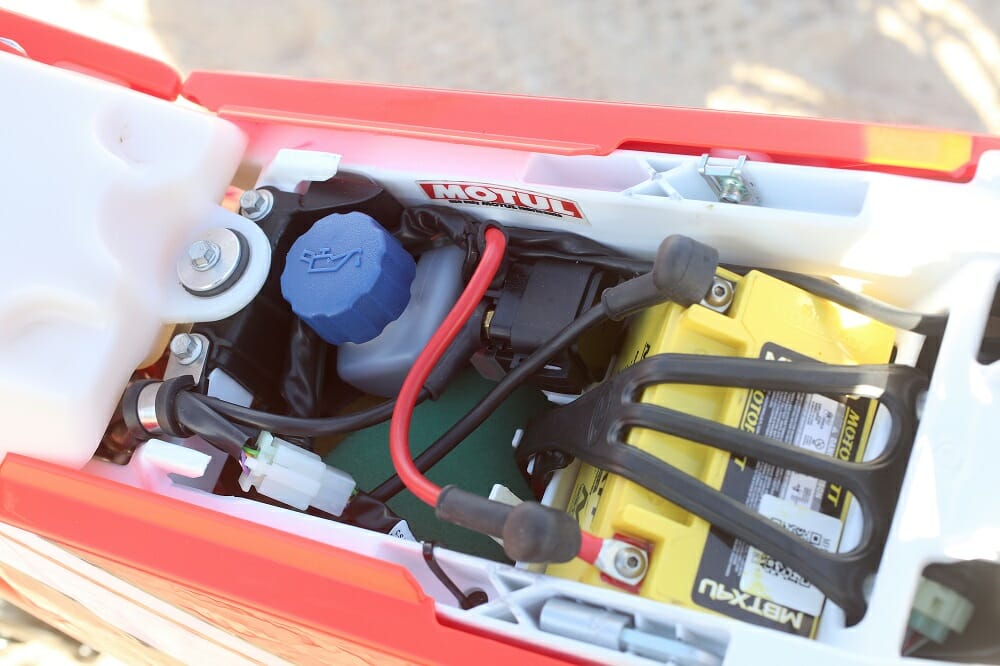
Out in the Elements
Again, the only difference between these two bikes is just over 44cc of displacement, which makes it hard to believe that they feel so different out on the trail. They both are light, narrow and nimble, but the 250 RR feels quite a bit more agile. The 250 RR likes to be ridden more aggressively and happily rips through the mid-power right into a strong and smooth top-end. There is plenty of bottom-end grunt when things get tight and technical, especially for lighter riders and those willing to cover the clutch. The snappy engine has lots of power on tap to pop and jump over rocks, logs and whatever else is in the way. Not all off-road riders want the off idle torque a 300 provides. Lighter riders, under 175 pounds and faster more advanced riders will prefer the 250 RR engine over the 300 RR. It vibrates less and has better top-end over rev. Testers over 200 pounds favored the 300 RR’s ability to lug and find traction with minimal clutch work and still pull strongly all the way to the higher rpms.
Off-road and trail riders have long known that 300 two-strokes are magic in low-speed conditions and crave the ugly stuff. The tighter and more technical the trails, the more the Beta 300 RR excels. Abundant torque and a healthy bottom-end help get you out of almost any seemingly hopeless situation. And those familiar with the stall and flame-out of four-strokes can rest assured the 300 engine will lug down to idle without a hiccup. The Beta 300 RR just keeps chugging along, working it’s way through nasty terrain, easier than the 250 RR. When the trail starts flowing, the Beta 300 RR is ready to snap to life and pull hard through the mid and into a strong top-end. It doesn’t scream on top like the 250 RR, but it will provide plenty of pulling power, especially under a heavy load.
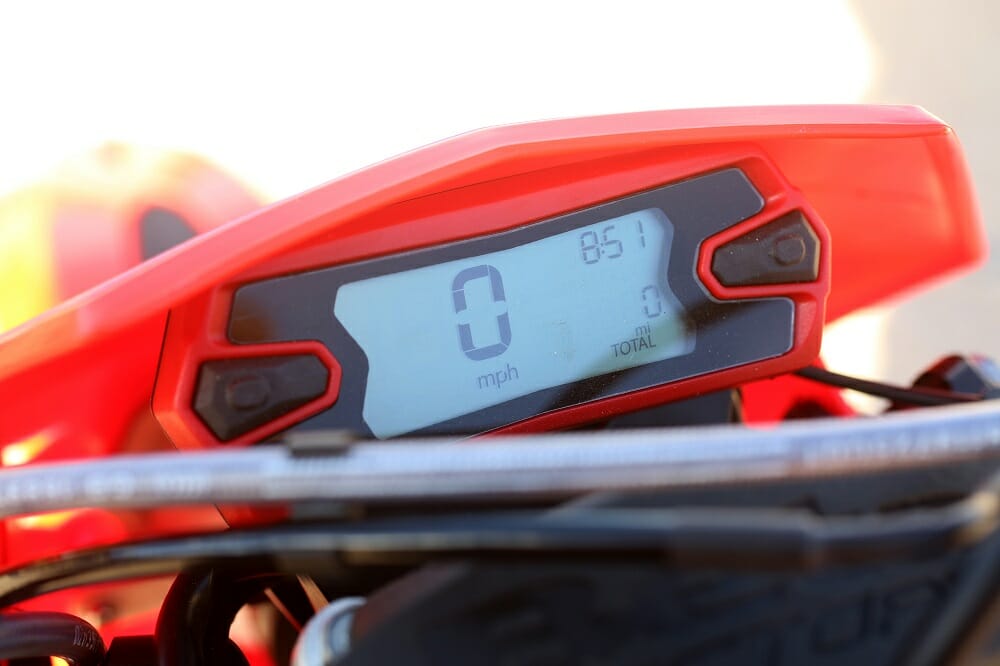
Overall the 300 RR is more linear when it comes to power delivery and for a lot of riders that is exactly what they are looking for from a two-stroke. Both engines have an adjustable power-valve, which can be used to adjust how hard the power hits and is worth adjusting until you find the ideal delivery. While both the 250 RR and 300 RR feature a dual-map ignition switch, one map for slippery conditions and one for normal conditions, we chose the standard (designated by a picture of the sun) over the slick conditions map (designated by a picture of a cloud and rain). This is a rider preference option, but since the engines are so smooth and controllable in the standard map, we most often chose that.
While it wasn’t bad, we noticed more vibration from the 300 RR when compared to the 250 RR. The six-speed transmission (same on both bikes) works nicely with the power delivery and shifts are smooth and easy.
Of course we love the hydraulic clutch. The pull is smooth and the action is consistent no matter how much abuse we dish out.
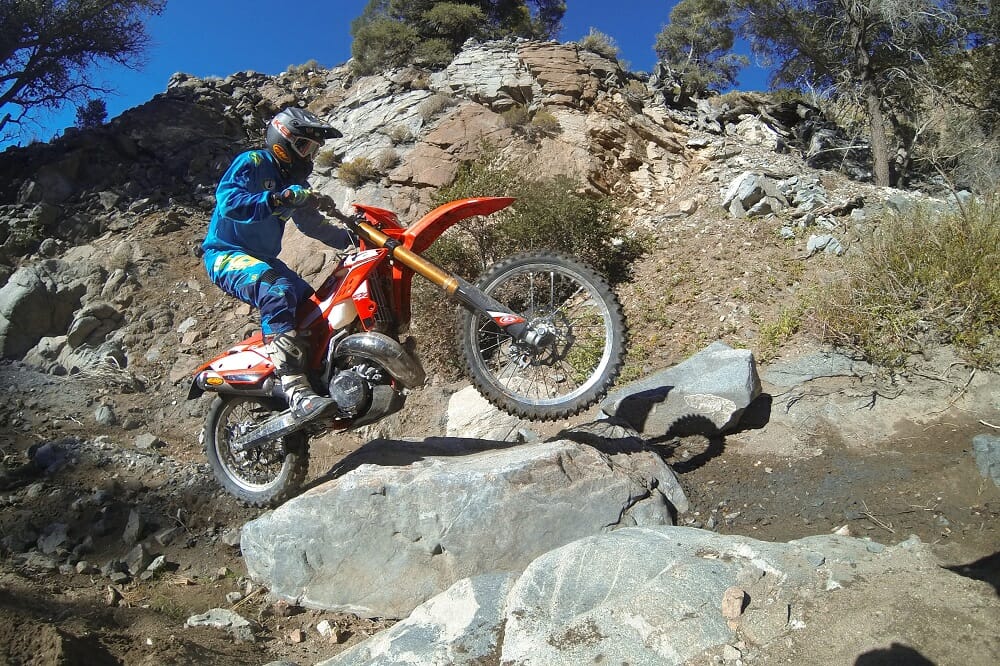
The Michelin enduro tires offer good traction for most terrain, expect for sandy loose conditions where the low knobs on the rear tire struggle to provide much forward drive. They work well on hard and rocky surfaces and when conditions are wet.
Every year Sachs improves suspension performance on the Betas. The 250 RR and 300 RR are designed as trail bikes (think enduro), so the suspension settings are fairly soft. The plushness works great when the going gets slow and tough, absorbing the roots and rocks that trail riders encounter. The setup of the 250 RR and the 300 RR is not for high-speed terrain or motocross; instead, it works very well for what it’s intended to do, ride off-road. With the same settings, both the 250 and 300 are well balanced. We ran between 105-110mm of sag depending on the terrain. For bigger and faster riders, going in a few clicks on compression helped hold the fork up in the stroke. These are trail bikes and that’s where they work best.
We rode some more open trail with decent whoops and the plush suspension handles the bigger bumps okay but definitely starts to pack up over consecutive hits. Unexpected g-outs will bottom the suspension, again reminding us that the slower and nastier terrain is the comfort zone.
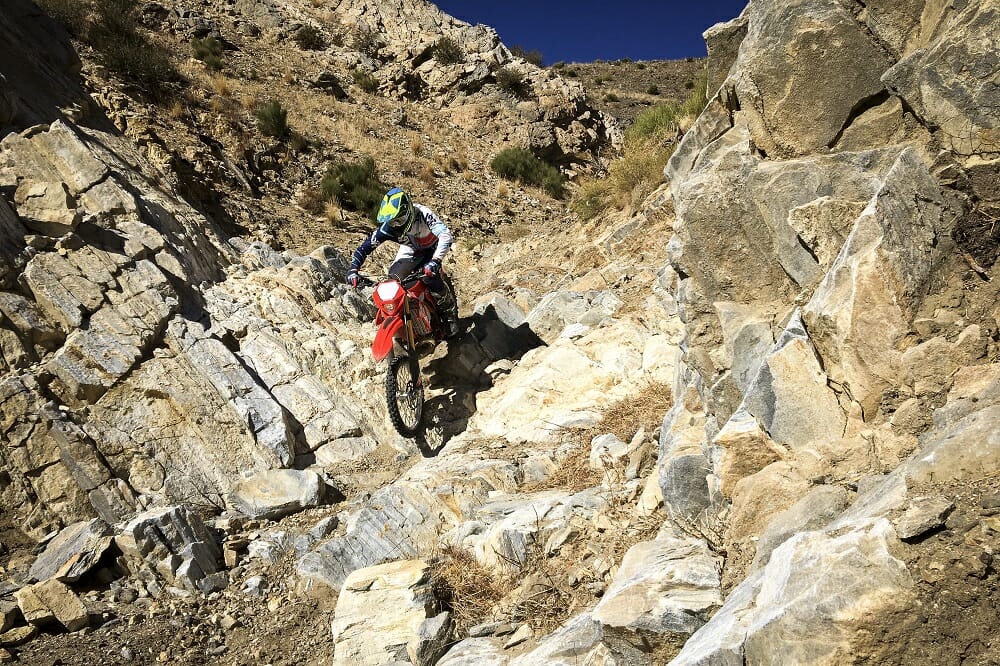
The overall feel from the Beta’s, especially on faster flowing single track is stability. The stability also helps keep the bike going in a straight line through rocky creek beds. If you are looking for a more aggressive suspension set up, Beta sells the 250 and 300 in a Race Edition that has different suspension set up for faster terrain and racing.
The Beta 250 and 300 come with FMF exhaust systems and we were a little heart broken when we fell over once in a rocky canyon and substantially smashed the FMF pipe on the 300. That is one downfall to two-strokes when off-roading—the pipes are often in harms way, but, luckily, aren’t crazy expensive when it comes time to replace them, and there are a lot of aftermarket companies that make guards to help protect them.
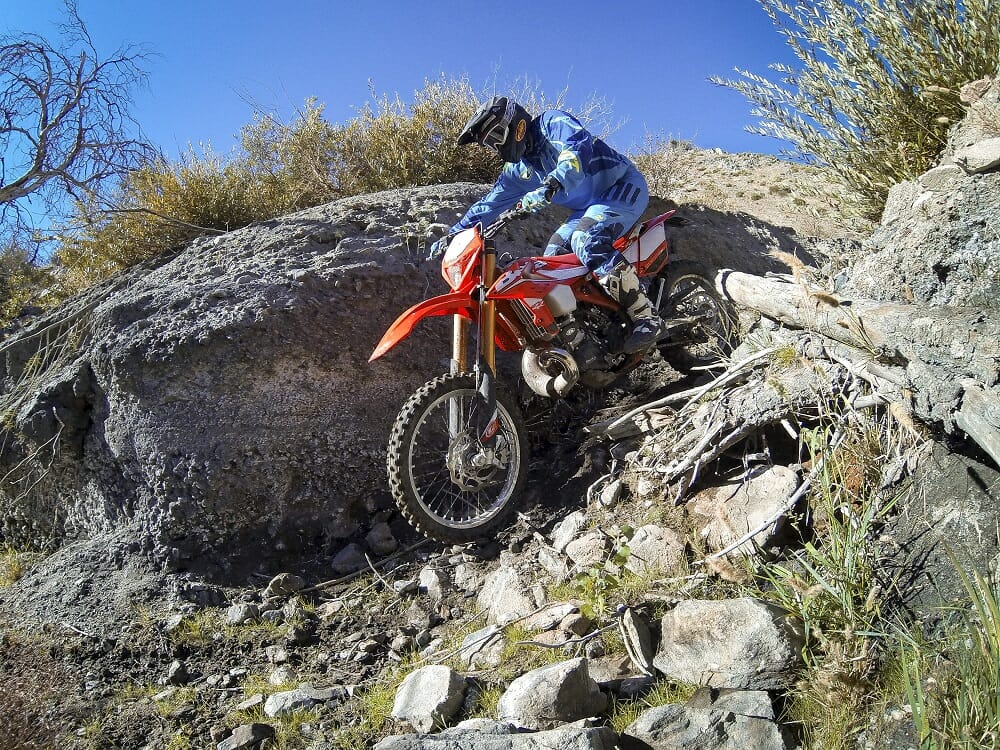
Clear Winner?
Neither one of the two-stroke Beta RRs is really better than the other. There is, however, a better engine displacement for your style of riding and it’s up to you to decide what that is. A factor in choosing between the two is your weight. If you are a lightweight, around 150-175 pounds, the 250 RR power will feel much like the 300 RR would to someone coming in over 200 pounds. The 250 RR has a little less vibration and overall is a more exciting engine that revs higher, but it doesn’t lug as well as the 300 down low.
Overall handling is similar, the 250 RR just feels a little more nimble thanks to less rotating engine mass. The Cycle News staff is split between choosing a favorite; half of the testers liked the 250 RR while the other half adored the 300 RR.
But it’s all about riding style. CN

|
SPECIFICATIONS: 2017 Beta 300 RR / 250 RR |
|
|
Engine: |
Single-cylinder, two-stroke |
|
Displacement: |
293.1cc / 249cc |
|
Bore x Stroke: |
72 x 72 mm / 66.4mm x 72mm |
|
Cooling: |
Liquid-Cooled |
|
Compression Ratio: |
12:1 / 12:8.1 |
|
Fuel System: |
Keihin PXK 36 mm |
|
Starting System: |
Electric start w/ back-up kick starter |
|
Transmission: |
6-speed |
|
Lubrication: |
Oil-injection |
|
Final Drive: |
O-ring chain |
|
Seat Height: |
36.6 in. |
|
Wheelbase: |
58.3 in. |
|
Ground Clearance: |
12.6 in. |
|
Front Suspension: |
48mm Sachs USD fork, adjustable compression/rebound, TFX technology |
|
Rear Suspension: |
Aluminum Body Sachs shock w/adjustable rebound and hi/low-speed compression |
|
Front Brake: |
260mm |
|
Rear Brake: |
240mm |
|
Front Tire: |
21-in. Michelin Enduro Competition |
|
Rear Tire: |
18-in. Michelin Enduro Competition |
|
Fuel Capacity: |
2.5 gal. |
|
Claimed Dry Weight: |
224 lbs. |
|
Claimed Wet Weight |
250 lbs. |
|
MSRP: |
$8,499 |
To read this in Cycle News Digital Edition Magazine, click HERE
Click here for more Beta motorcycle reviews and news.
